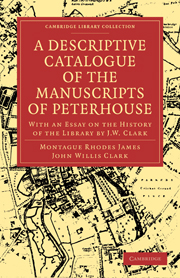 A Descriptive Catalogue of the Manuscripts in the Library of Peterhouse
A Descriptive Catalogue of the Manuscripts in the Library of Peterhouse Published online by Cambridge University Press: 07 September 2010
A respect for books, that is to say, manuscripts, was one of the most striking characteristics of the Middle Ages; and writers of that period, whether secular or religious, vie with one another in inventing epigrammatic phrases to shew their sense of the value of such possessions, and of the duty of safeguarding them against injury or loss.
In the Rule of S. Benedict daily reading is specially inculcated as a remedy for “ idleness the enemy of the soul” in the following words :
Between Easter and the calends of October let brethren apply themselves to reading from the fourth hour till near the sixth hour….
From the calends of October to the beginning of Lent let them apply themselves to reading until the second hour… During Lent let them apply themselves to reading from morning until the end of the third hour…and, in these days of Lent, let them receive a book apiece from the library, and read it straight through….
As time went on, the distribution of the books of the House among the brethren at the beginning of Lent for use during that season was extended. Books were distributed as heretofore at the beginning of Lent, but each brother was allowed to keep his volume for a whole year. In the statutes which Lanfranc promulgated for the use of English Benedictines in 1070, and which, as he tells us, were based on common monastic practice, the keeper of the books is directed to bring all the volumes 1 under his charge into Chapter at the beginning of Lent, with the exception of those which had been assigned for reading a year previously, and to lay them out upon a carpet.
To save this book to your Kindle, first ensure [email protected] is added to your Approved Personal Document E-mail List under your Personal Document Settings on the Manage Your Content and Devices page of your Amazon account. Then enter the ‘name’ part of your Kindle email address below. Find out more about saving to your Kindle.
Note you can select to save to either the @free.kindle.com or @kindle.com variations. ‘@free.kindle.com’ emails are free but can only be saved to your device when it is connected to wi-fi. ‘@kindle.com’ emails can be delivered even when you are not connected to wi-fi, but note that service fees apply.
Find out more about the Kindle Personal Document Service.
To save content items to your account, please confirm that you agree to abide by our usage policies. If this is the first time you use this feature, you will be asked to authorise Cambridge Core to connect with your account. Find out more about saving content to Dropbox.
To save content items to your account, please confirm that you agree to abide by our usage policies. If this is the first time you use this feature, you will be asked to authorise Cambridge Core to connect with your account. Find out more about saving content to Google Drive.